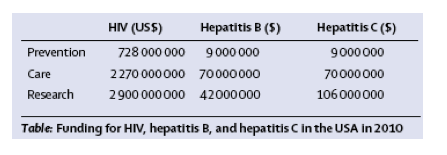| |
From the big three to the big four [Hepatitis] / little HCV Funding Comment
|
| |
| |
Download the PDF here
"viral hepatitis as a global health issue.....data show a comparable burden of viral hepatitis with the big three infectious diseases-HIV, malaria, and tuberculosis.....Financial investment in responding to viral hepatitis is minimal at a global level.....In the USA, although hepatitis C is at least five times more prevalent than HIV, little funding has been directed to improving prevention, care, or research.....Global agencies, such as the World Bank and global philanthropic organisations, will need to acknowledge the data, recognise the burden, and dedicate resources commensurate to the need-that is, to tackle viral hepatitis as one of the big four infectious diseases of our time"
The Lancet Infectious Diseases June 2015
*Ding-Shinn Chen, Stephen Locarnini, Jack Wallace
Coalition to Eradicate Viral Hepatitis in Asia Pacific, (CEVHAP), 20 Upper Circular Road, #02-10/12, The Riverwalk, Singapore, 058416
The increasing global burden of viral hepatitis was recognised by the World Health Assembly with the passing of two resolutions, the first in 2010,1 followed by a second in 2014.2 These resolutions identified viral hepatitis as a global health issue needing an "integrated and cost-effective approach" to its prevention, control, and management. At a global level, viral hepatitis is responsible for 1·44 million deaths every year (compared with 1·46 million deaths from HIV/AIDS, 1·20 million from tuberculosis, and 1·17 million from malaria). In Asia, the situation is different, with deaths from viral hepatitis outnumbering those from HIV, malaria, and tuberculosis combined.3 The data show a comparable burden of viral hepatitis with the big three infectious diseases-HIV, malaria, and tuberculosis-identified by the UN Millennium Development Goals (MDGs) for eradication.
A successful global response to viral hepatitis relies on a successful response to the epidemic in Asia, where 76% of the global population with viral hepatitis lives, and where 74% of the global deaths related to these infections occur.4
Financial investment in responding to viral hepatitis is minimal at a global level with no mention of chronic viral hepatitis in the MDGs. In the USA, although hepatitis C is at least five times more prevalent than HIV, little funding has been directed to improving prevention, care, or research (table).5 The World Health Assembly resolutions provided the rationale for the establishment of the Global Hepatitis Program within WHO, and the development of the Prevention and control of viral hepatitis infection: framework for global action in 2012. This framework was to provide national governments a structure to develop effective strategies and plans according to their specific hepatitis burden and challenges.

Despite the limitations, remarkable advances have occurred over the past decade in the Asia-Pacific region. The hepatitis B vaccination programme in China has effectively decreased the prevalence of chronic infection for people aged between 1 and 59 years from 9·8% in 1992 to 7·2% in 2006.6On an individual level, this has meant that between 24 million and 30 million hepatitis B infections and 4·3 million deaths of children born after 1992 have been prevented. At the same time, the burden on people living with chronic viral hepatitis remains. The Needs assessment of people with viral hepatitis-China, funded by the Coalition to Eradicate Viral Hepatitis in Asia Pacific, done by La Trobe University, and to be released in summer 2015, found that people were diagnosed through educational or employment institutions, by a teacher or human resources staff with little information provided to people about their infection; treatment decision making was often based on economic rather than clinical factors; and although discriminatory regulations were repealed in 2009, stigma remains a key issue.
WHO has committed to developing a global response that recognises the fragmented and inadequate responses to viral hepatitis by governments. The Australian experience shows that although a strategic response is available, it is of little use unless resources are provided. Despite few economic barriers to accessing treatment in a country such as Australia, and the existence of a national response to viral hepatitis, less than 5% of people with viral hepatitis have ever accessed clinical services. Patient and physician barriers to treatment uptake must be identified and overcome, but funding for implementation of the strategy is clearly grossly inadequate.
Although global, regional, and national activity is needed to develop strategic responses, these should use partnership models in which stakeholders such as clinicians, primary care physicians, researchers, government, and communities with and at risk of the infection are included. The strategies need to include clear, concise, and achievable outcomes, and, importantly, resources to ensure that the individual and social burden of hepatitis is effectively reduced.
It is vital that global institutions recognise that a systematic approach to reducing the mortality of viral hepatitis is going to need more than action plans. Global agencies, such as the World Bank and global philanthropic organisations, will need to acknowledge the data, recognise the burden, and dedicate resources commensurate to the need-that is, to tackle viral hepatitis as one of the big four infectious diseases of our time.
We declare no competing interests. The mission of the Coalition to Eradicate Viral Hepatitis in Asia Pacific (CEVHAP) is to reduce the substantial health, social, and economic burden of viral hepatitis in Asia Pacific. We are committed to working with others who share a vision of a world free of viral hepatitis, and to assist policymakers and their governments in the development of coordinated national action plans to combat the disease within the WHO Framework for Global Action.
|
|
| |
| |
|
|
|